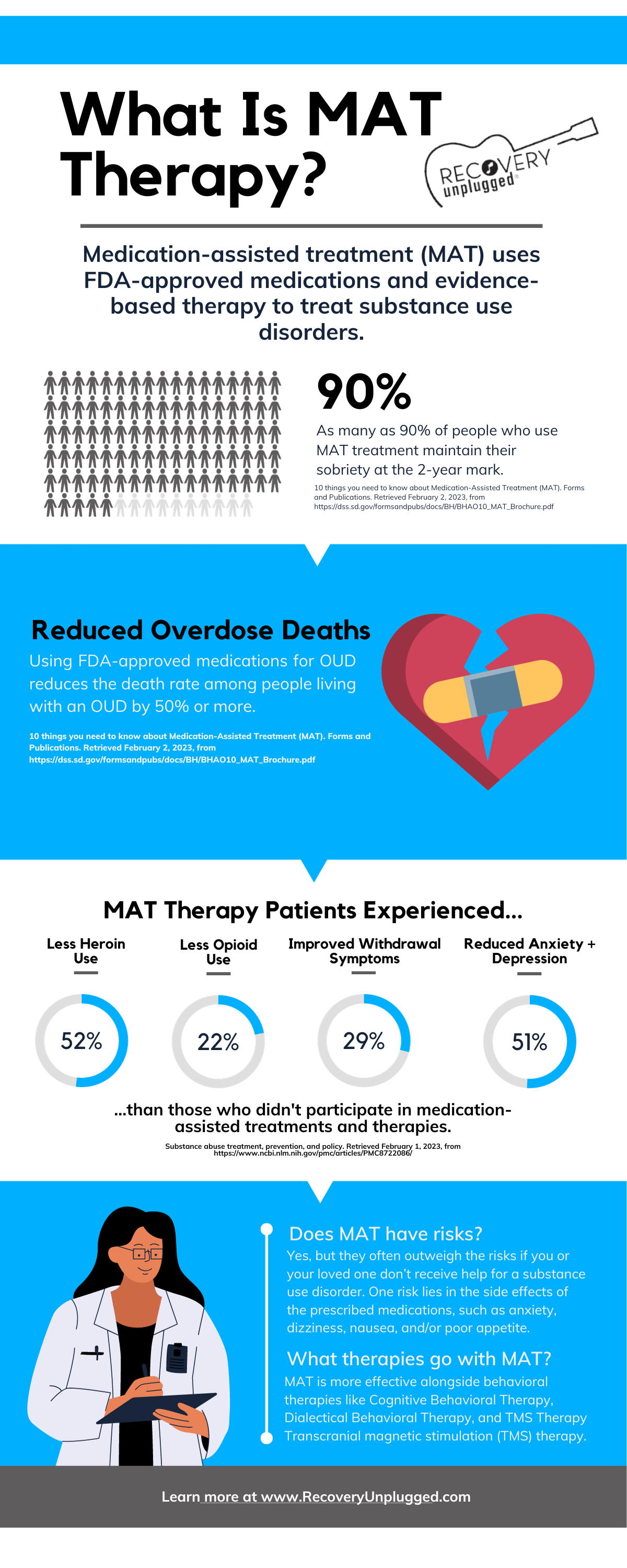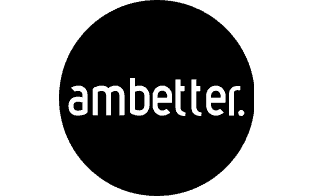While the treatment of substance use disorders has grown and provides multiple options, they’ve long compartmentalized the use of medications and therapy. Medication-Assisted Treatment (MAT) combines FDA-approved medications with counseling and behavioral therapies to treat substance use disorders, with a focus on opioid and alcohol dependencies, aiming to improve patient survival, increase retention in treatment, and reduce illicit opiate use and other criminal activity among people with substance use disorders.
MAT Therapy Defined
Medication-Assisted Treatment uses FDA-approved medications, counseling, and behavioral health therapy to treat substance use disorders, such as alcohol and opioid dependence. The medications used in MAT work by various mechanisms, such as alleviating cravings and withdrawal symptoms, blocking the euphoric effects of alcohol and drugs, and stabilizing brain chemistry.
Counseling and therapy offer you the chance to fully understand the motivations and triggers behind substance use while gaining skills and mechanisms to sustain recovery on a daily basis.
Uses for Medication-Assisted Treatments
This evidence-based treatment is used for several substance use disorders to manage withdrawal symptoms and prevent opioid overdose in those dependent on prescription medications and illicit substances.
Alcohol Use Disorder (AUD)
Because alcohol is conveniently available throughout the U.S. while being extremely socially acceptable, many people develop an Alcohol Use Disorder without realizing it. These circumstances also make it difficult to overcome AUD without professional help. Common medications used with MAT for AUD are acamprosate, disulfiram, and naltrexone.
Acamprosate
This medication benefits you if you’ve gone through the initial detoxification phase and withdrawal symptoms. Acamprosate is given as a tablet on the fifth day of sobriety and reaches full effectiveness within eight days of your first dose. Its main effect is craving reduction while improving your odds of recovery when used with counseling and therapy.
Disulfiram
This medication is most effective if you’ve completed detox and are starting the early recovery stages. Disulfiram is a tablet given once a day and works as a deterrent to alcohol use by producing disagreeable side effects with any alcohol use, like chest pains, difficulty breathing, headache, nausea, and vomiting.
Naltrexone
Naltrexone, or brand name Vivitrol®, is an injectable medication that interferes with the euphoric feelings many people associate with alcohol intoxication. The medication creates a disconnect between pleasurable feelings and alcohol consumption. Like other AUD medications, naltrexone is most effective when used along with counseling and therapy.
Opioid Use Disorder (OUD)
Opioid use disorder affects thousands of people in the U.S. each year. The proliferation of prescription opioids along with synthetic versions can make the situation seem untenable for those who want to stop using the substance.
MAT for OUD often includes a detoxification process, but it is not always the initial step; MAT can be initiated in various stages of addiction and recovery, tailored to individual needs as determined by healthcare providers. Buprenorphine, methadone, naltrexone, and Suboxone® are common medications used in MAT and are safe to use as long as necessary, including for a lifetime.[1]
Buprenorphine
This medication is a partial opioid agonist, meaning when taken as prescribed, it diminishes opioid withdrawal symptoms and cravings. Buprenorphine treatment begins when you’ve started the early stages of opioid withdrawal, such as at least 12 to 24 hours after the last use. Because it’s a long-acting medicine, your healthcare provider may change your dose from every day to alternating days once you’ve stabilized.[2]
Methadone
Methadone is a long-acting, full opioid agonist that reduces cravings and withdrawal symptoms while blocking the effects of opioids. It’s taken daily in a diskette, liquid, or powder form. Because methadone is used to treat people with a confirmed OUD, it has to be given with the supervision of a licensed provider. You may be able to transition to taking methadone at home if you meet the stability requirements set by your treatment plan.
Naltrexone
Naltrexone is a non-addictive medication that blocks the commonly felt euphoric and sedative effects of opioids by binding to or blocking opioid receptors in your brain. It also reduces and stops cravings and doesn’t trigger withdrawal symptoms if you stop taking naltrexone. Naltrexone treatment starts when at least seven days have passed after the last use of short-acting opioids and up to 14 days for long-acting forms.
Suboxone (buprenorphine/naloxone)
Suboxone is an opioid prescription used to stabilize withdrawal symptoms during detox while maintaining treatment during recovery. It blocks the effects of other opioids, while naloxone prevents misuse of the medication. Suboxone treatment should be initiated when signs and symptoms of withdrawal are present, which may vary in timing after the last opioid use, depending on individual metabolism and the specific opioid used.
Substance Use Disorder (SUD)
MAT is highly effective for many substance use disorders as it helps sustain recovery so you or your loved one are able to overcome the use disorder. The combination of medications specific to your use disorder, such as buprenorphine treatment, coupled with counseling and therapy methods geared toward you as an individual, drive MAT’s success rate. It also provides assistance and support during and after the detox phase that many other treatment options don’t.
Co-Occurring Disorders
Co-occurring disorders — the situation where a mental illness and substance use disorder happen at the same time — are common among people in MAT. 9.2 million adults in the U.S. have a co-occurring disorder.[3] Misused substances are common alcohol, hallucinogens, marijuana, opioids, prescription drugs, stimulants, and tobacco.
Mental disorders clinicians and providers frequently see in substance use disorder treatment include:
- Anxiety and mood disorders;
- Attention deficit hyperactivity disorder (ADHD);
- Bipolar disorder;
- Conduct disorders;
- Major depressive disorder;
- Post-traumatic stress disorder; and
- Schizophrenia.
New information has shown that if you have a co-occurring disorder and receive MAT, you’re more likely to remain sober. Patients with some conditions also experienced a decline in symptoms after participating in counseling and MAT. Other benefits you may see include decreased risks of homelessness, incarceration, and unemployment.
Prescription Medications Used For MAT Therapy [CHART]
|
Brand Name |
Generic Name |
Method of Ingestion |
| Dolophine | Methadone hydrochloride | Tablet |
| Methadose | Methadone hydrochloride | Oral concentrate |
| Bunavail | Buprenorphine & naloxone | Buccal film |
| Cassipa | Buprenorphine & naloxone | Sublingual film |
| Probuphine | buprenorphine | Implant |
| Sublocade | Buprenorphine extended-release | Injection |
| Suboxone | Buprenorphine & naloxone | Sublingual film or tablet |
| Subutex | Buprenorphine | Sublingual tablet |
| Zubsolv | Buprenorphine & naloxone | Sublingual tablet |
| Vivitrol | Naltrexone extended-release injectable suspension | Intramuscular injection |
Substance use disorder usually requires the help of professional treatment providers to achieve lasting recovery. If you or a loved one are ready to begin your journey to recovery, contact Recovery Unplugged today to learn about our inpatient and outpatient treatment programs.
How MAT Therapy Works
MAT aims to find and treat the root cause of substance use disorders and ultimately allow you or your loved one to live your best life. This means the treatment you receive is customized to your situation and needs using information from the intake care assessment performed by a trained clinician.
Generally, MAT is used in three levels of care: partial, intensive outpatient, and outpatient care. Depending on your assessment, you may begin at the highest level and stair-step down over time, or you might start at a lower level.
The medication you’re prescribed while in MAT is designed to alleviate the psychological cravings, normalize your brain chemistry and other bodily functions, and block the euphoric effects. For example, methadone and buprenorphine work together to make the opioid receptors in your brain think you’ve taken an opioid but without the effects of opioids.
Counseling, therapy, and psychosocial support augment the medications to help you or your loved one understand emotions and triggers, learn how to handle cravings outside of treatment, and enhance coping skills needed to transition back into everyday life.
MAT Therapy Timeline
Keep in mind the timelines given here are estimates based on the professional information. MAT can be short-term or long-term depending on a range of factors that your healthcare provider will discuss. The proposed timeline can change as needed, too.
MAT for AUD
Professional opinions vary, but MAT for AUD is generally thought to be most effective when a client stays in a treatment plan for at least six months and up to one year.
MAT for OUD
It can depend on your situation and needs, but most MATs for OUD are created for long-term use. The changes to your brain chemistry after opioid use often linger throughout your life and make MAT programs necessary to lessen their impact.
MAT for SUD
Like other MAT plans, how long you need to stay in a MAT for SUD depends on the length of use, severity, physical health, personal goals, and other factors. Some people may need a few months to accomplish their benchmarks, while others need at least one year.
Medication-Assisted Treatment Studies and Statistics
Although MAT has been around since the 1960s, it’s only gained recognition with more medical and scientific studies in recent decades. Several studies have found the efficacy of MAT to be in line with predicted outcomes, though research is ongoing.
A 2022 study that focused on adults with OUD in rural Colorado found decreased substance use, improved mental and physical health, and reduced symptoms after six months of MAT. Patients in the study reported less heroin use (52.1% vs. 20.4%), opioid use (22.3% vs. 11%), and alcohol use (28.6% vs. 13.1%) while experiencing improved symptoms (29.8% vs. 21.3%), anxiety (49.7% vs. 23.2%), and depression (54.1% vs. 23.3%) after treatment.[4]
Up to 90% of people who use MAT maintain their sobriety at the 2-year mark.[5] And using FDA-approved medications for OUD reduces the death rate among people living with an OUD by 50% or more.[6]
Goals and Benefits Of MAT Therapy
While the granular goals of each MAT therapy program are different, the overall goal is to help you or your loved one safely and successfully complete the journey to recovery from substance use. It begins by controlling specific conditions at the beginning stages of recovery, then tapering off prescribed medications and leaning into functional and healthier behaviors.
Though MAT has only gained more widespread use in recent years, it offers numerous benefits to anyone who participates. Because the programs are designed to steadily lessen medical and therapeutic supervision, you have the autonomy to reintegrate into daily life with as much support as needed. This could be through daily one-on-one counseling sessions or weekly support groups.
Key benefits you or your loved one may experience with MAT therapy include:
- Curbed or eliminated intense cravings that generally occur during withdrawal;
- Increased level of involvement with the treatment plan;
- Relief from discomfort and/or pain associated with withdrawal symptoms and/or
- Reduced potential of an overdose and/or relapse.
Because the medications in MAT either significantly reduce or nearly eliminate common withdrawal symptoms, you or your loved one are more likely to stay in the treatment program. The longer you participate, the more likely the program will be effective.
What To Look For In A Medication-Assisted Treatment Center
One search online reveals the numerous treatment facilities available to treat any number of substance use disorders. But finding one that meets the needs of yourself or a loved one can be difficult in an already overwhelming situation.
Look for a facility that puts the individual at the forefront and approaches their recovery from a holistic view. This often begins with empowerment, passion, and strength, characteristics fueling each supportive step of your journey. A handful of questions to ask when searching for a facility include:
- Do your programs use evidence-based practices?
- What post-treatment recovery support do you offer?
- Does treatment include family education and/or support?
- Are physical well-being elements, like a healthy diet and regular exercise, included in programs?
- What does a successful recovery mean to you?
Along with being patient-focused, a treatment facility should be supportive beyond counseling and therapy sessions. This can be in the form of outdoor walking paths where you can take in nature. Or, the facility allows you to bring your pet, who’s shown steadfast love and support throughout your journey. Art and other creative outlets can help you express emotions that are sometimes difficult to verbalize.
MAT Treatment Programs
The crux of any MAT treatment program should be a customized and holistic approach to treatment for you or your loved one. This ensures treatment focuses on potential underlying causes and what’s truly best for your long-term recovery.
Most facilities offer inpatient or outpatient treatment options or both. Following are the traditional program structures.
- Detoxification: Comfortably and safely navigate the detox phase with medical guidance and support for 5 to 7 days.
- Inpatient treatment: This program allows you to focus on recovery without distractions, from detox and withdrawal management into treatment, for 7 to 24 days. Inpatient or residential treatment offers a range of amenities and opportunities to support your physical well-being during treatment and more.
- Partial hospitalization programs (PHP): This program blends customization and flexibility for inpatient treatment or daily sessions.
- Intensive outpatient (IOP): This program offers in-depth but flexible treatment and independence.
- Outpatient treatment: This program offers the flexibility of attending to daily life responsibilities while receiving comprehensive and high-quality treatment.
MAT Alongside Behavioral Therapies
As discussed, medication alone isn’t enough for a successful recovery from substance use. MAT is optimized when it is part of an integrated approach that includes treatment for mental and behavioral health issues by qualified healthcare professionals.
Cognitive Behavioral Therapy
A common therapy in substance use treatment, cognitive behavioral therapy lets you or your loved one work one-on-one with a professional to discuss one or more issues that disrupt your quality of life. This therapy identifies root causes and supporting factors while you learn healthy coping mechanisms.
Dialectical Behavioral Therapy
A form of CBT, dialectical behavioral therapy focuses on treating specific mental health issues while helping you or your loved one learn how to control emotions, tolerate distress, behavior reinforcement, and radical acceptance.
TMS Therapy
Transcranial magnetic stimulation (TMS) therapy is an effective treatment for people with co-occurring disorders, such as depression and substance use disorder. Magnetic pulses stimulate nerve cells within your brain involved in depression and mood control, activating the areas with decreased activity.
Safely Navigate Withdrawal Symptoms With MAT Therapy At Recovery Unplugged
Don’t let substance use withdrawal symptoms dictate the success of your recovery. Contact Recovery Unplugged today to learn how our MAT therapy puts you in control of your journey.


























